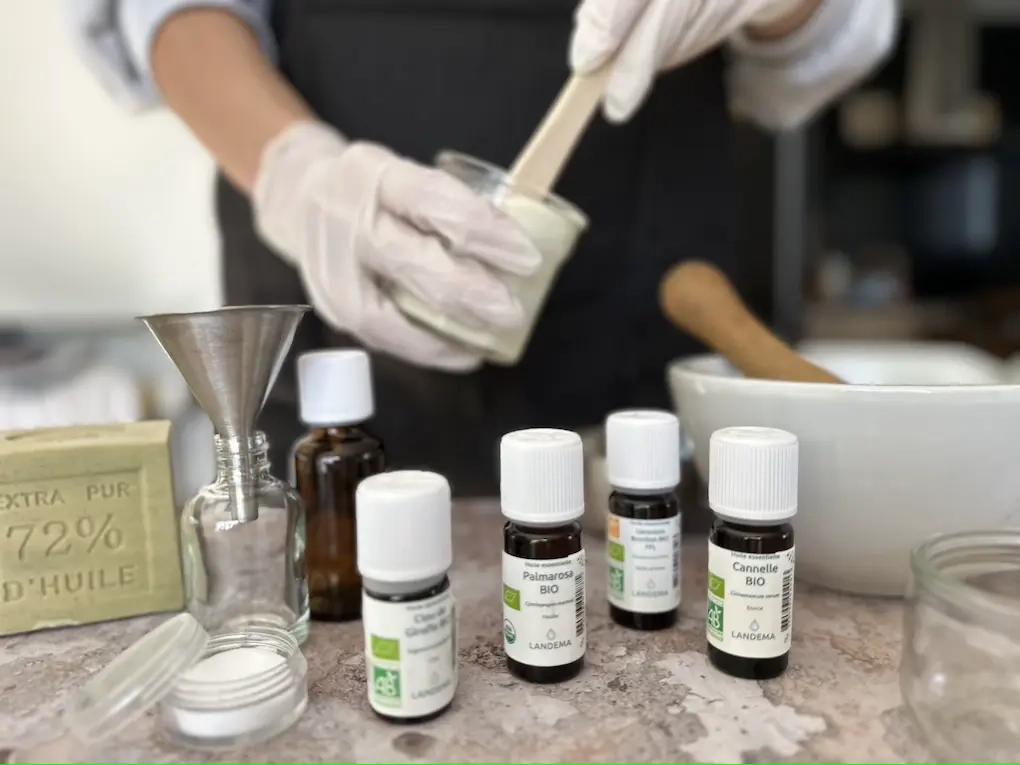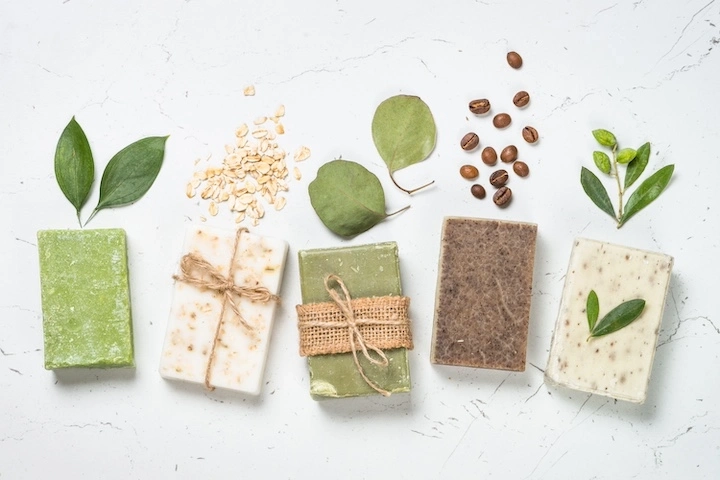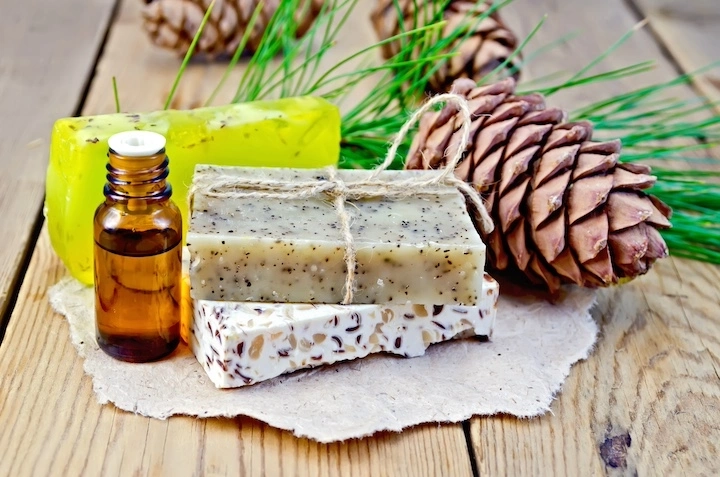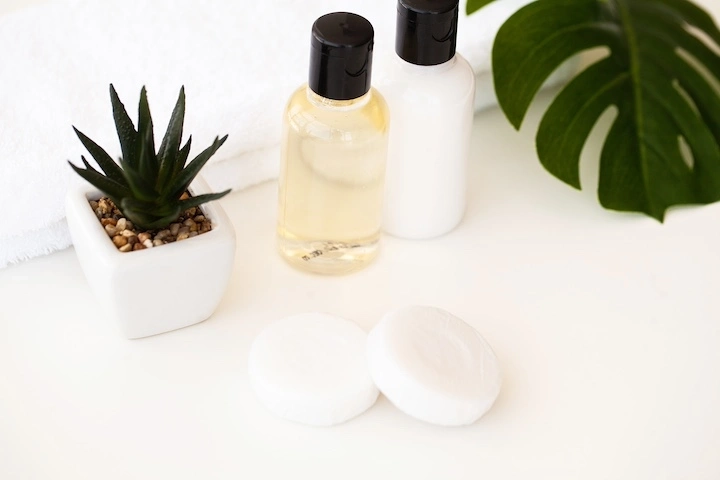
The best essential oils for pampering skin: a practical guide for Cosmetics and Soaps
08 février 2024Introduction to the power of essential oils for Skincare
In the realm of beauty and wellness, essential oils stand out for their natural and effective enhancement of skin appearance. These pure essences, extracted from plants, are nature's treasures brimming with skin-beneficial properties. Whether you aim to soothe, tone or even relieve specific skin issues with the cosmetics and soaps you create, there is an essential oil suited to your needs.
In this guide aimed at both skincare product professionals and DIY cosmetics enthusiasts, we dive into the fascinating world of essential oils, exploring how they can be incorporated into the manufacturing of cosmetics and soaps.
Discover the most appropriate essential oils for different skin types and skincare products, learn how to integrate them into your formulas, and gain practical tips for using these potent extracts safely and effectively.

1/ Formulation guide for Cosmetic products:
Formulating cosmetic products with essential oils is a delicate art that requires an in-depth understanding of their properties, scents, and compatibilities with different product types.
Selecting essential oils based on their properties
Each essential oil has distinctive properties. For instance, some are soothing while others are toning. It is crucial to know these properties to select the right essential oil for your needs and your formulation goals. Here's a selection of the best essential oils for skincare and their properties according to literature and traditional uses:
● Geranium (Pelargonium graveolens): Soothing and anti-inflammatory, ideal for anti-aging facial care and skin issues like rosacea.
● Palmarosa (Cymbopogon martinii): Antifungal and anti-infection, healing, perfect for anti-acne care and deodorants.
● Peppermint (Mentha x piperita): Refreshing, antiseptic and toning, excellent for gels for heavy legs and aftershave care. Note: it is not recommended for children's products.
● Rosemary with cineole (Rosmarinus officinalis cineoliferum): Toning, it is often used in hair care and exfoliants, as well as for its scent.
● Carrot (Daucus carota): Regenerating and anti-pigmentation, effective against skin conditions in general, wrinkles and age spots.
● Patchouli (Pogostemon cablin): Venous decongestant and anti-inflammatory, ideal for anti-acne care, against varicose veins and rosacea, but use sparingly due to its strong scent.
● True Lavender (Lavandula angustifolia): Anti-inflammatory and soothing, healing, refreshing, used for products aimed at relieving allergies, itching, burns. Slightly photosensitising.
● Petitgrain Bigarade (Citrus aurantium var. amara): Anti-inflammatory and disinfectant, beneficial for acne and eczema, and highly appreciated for its scent.
● Ylang-Ylang (Cananga odorata): Tonic for the skin and hair, with its feminine and sensual fragrance it is often found in lotions, creams, and shampoos.
● Italian Helichrysum (Helichrysum italicum): Healing, anti-bruising, lipolytic, recommended for repair and anti-aging care and oily skins.
Summary Table
The following table summarises important information on these essential oils, their properties, their specific uses in cosmetics, and the precautions specific to them, providing a useful guide for their incorporation into skincare products:
|
Essential Oil |
Main Components |
Properties |
Uses in Cosmetics |
Precautions and additional notes |
|
Geranium (Pelargonium graveolens) |
Citronellol, Geraniol |
Soothing, anti-inflammatory, astringent, hemostatic |
Facial care, anti-aging, couperose, rosacea, redness, leg care |
Prefer the Bourbon variety, it has a finer composition |
|
Palmarosa (Cymbopogon martinii) |
Geraniol |
Anti-infectious, antifungal, healing |
Deodorants, anti-acne care, disinfecting care, anti-cellulite products |
Interesting blend with Tea tree (Melaleuca alternifolia) and Lemon (Citrus limon) essential oils in deodorants |
|
Peppermint (Mentha x piperita) |
Menthol, Menthone |
Refreshing, toning, analgesic, disinfecting |
Heavy legs gels, after-shave care, inflammations, foot care |
Avoid in children's products due to ketone content; use for small areas of the body (cooling effect) |
|
Rosemary with cineole (Rosmarinus officinalis cineoliferum) |
1,8 Cineole |
Expectorant, antiviral, toning |
Hair care, exfoliation, perfumes |
Promotes hair growth |
|
Carrot (Daucus carota) |
Carotol |
Regenerative, anti-pigmentary |
Day and night creams, eye contour care, pigmentation spots |
Do not exceed 1% in formulations |
|
Patchouli (Pogostemon cablin) |
Patchoulol |
Venous decongestant, phlebotonic, anti-inflammatory, regenerative |
Leg lotion, varicose veins care, eczema, anti-acne |
Strong fragrance with oriental notes |
|
True Lavender (Lavandula angustifolia) |
Linalyl acetate, Linalool |
Anti-inflammatory, soothing, analgesic, healing, refreshing |
Soothing lotions, after-sun care, eczema care, perfumes |
Slightly photosensitizing due to coumarin content; reserve for night creams if used for facial care |
|
Petitgrain Bigarade (Citrus aurantium var. amara) |
Linalyl acetate, Linalool |
Anti-inflammatory, disinfectant |
Anti-acne care, eczema, perfumes |
Highly appreciated for its fragrance |
|
Ylang-Ylang (Cananga odorata) |
Benzyle benzoate |
Tonic for skin and hair, analgesic |
Body milks, creams, perfumes, shampoos, shower gels |
Strong scent; do not exceed 1% in formulas |
|
Italian Helichrysum (Helichrysum italicum) |
Italidiones, Neryl Acetate |
Anti-bruising, healing, venous tonic, lipolytic, anti-wrinkle |
Care for varicose veins and stretch marks, anti-cellulite, face creams, repair care, eye contour |
Do not exceed 1% in formulations. Prefer Corsican origin, the richest and finest |
Find all these essential oils at Landema's online store landema.com: it offers professional-quality plant extracts directly from the manufacturer in sizes ranging from 1ml to 25L.
Using essential oils in formulas and recommended dosages
Incorporating essential oils into cosmetic products requires a profound understanding of their dosages, particularly considering skin sensitivity and the concentration of active molecules in essential oils. Here is a guide to help you dose these natural essences correctly in your formulations.
Facial Care
Facial care requires special attention due to the delicateness of the skin in this area. Essential oils should be used in low concentrations, generally around 0.5 to 1%. As a reminder, 1 ml of essential oil is equivalent to approximately 30 drops.
Here are some examples:
● Moisturizing creams: Add 1 drop of essential oil per 10 ml of cream to reach approximately a 1% concentration.
● Serums: For a 30 ml serum, use a maximum of 3 drops of essential oil.
● Masks: Incorporate about 2 drops of essential oil per 10 ml of mask.
It is crucial to respect these dosages to avoid any irritation or sensitisation of the skin.
Body Care
For products intended for the body, where the skin is generally less sensitive than the face, slightly higher concentrations can be tolerated, typically between 2 to 3%. Here are some recommendations:
● Body lotions: Use up to 2% essential oil in the formulation. For example, for a 100 ml lotion, you can add up to 20 drops of essential oil.
● Massage oils: For 100 ml of base oil, add about 20 to 30 drops of essential oil, corresponding to a 2 to 3% dosage.
● Shower gels and rinsed products: Incorporate up to 2% essential oil.
Incorporating essential oils during production
To preserve all their properties, it is important to avoid heating the essential oils. Therefore, they should be incorporated at the very end of your production process, along with other heat-sensitive ingredients such as vitamin E.
It is also important to remember that essential oils are lipophilic: they dissolve in oily phases or fats but not in aqueous phases. This is a key consideration when selecting your products!

Photosensitising, dermocaustic or allergenic essential oils
The selection of essential oils for cosmetic products must also consider their potential to cause photosensitisation, skin causticity or allergic reactions. Here are some key points for safe and effective use.
Photosensitisation
Photosensitizing essential oils can increase skin sensitivity to the sun, leading to reactions such as burns or pigmentation spots. The molecule responsible for photosensitisation in essential oils is coumarin. It is primarily found in citrus essences such as Lemon (Citrus limon), Bergamot (Citrus bergamia), Green Mandarin (Citrus reticulata), or Sweet Orange (Citrus sinensis), for example.
Thus, they should be avoided in day creams, body lotions, sun products, etc.
However, Bergamot essential oil without bergaptene, which no longer contains coumarins, can be used to enjoy its fragrance or properties without the photosensitising aspect.
Dermocausticity
Dermocaustic essential oils can cause irritations or burns when applied in their pure form or at high concentrations on the skin. It is essential to dilute them correctly, to a maximum of 0.5% if they are to be included in a cosmetic product.
Among these essential oils are Cinnamon (Cinnamomum verum), Clove (Eugenia caryophyllus), Oregano (Origanum vulgare), and Thyme with thymol (Thymus vulgaris).
Allergenic Potential
Certain essential oils can provoke allergic reactions. It is important to perform a patch test before use if you are creating cosmetic products for yourself, especially if you have sensitive skin or a history of allergies. This involves placing 1 drop of essential oil on the wrist or the crook of the elbow and waiting 48 hours to see if a skin reaction occurs.
In cosmetics, as of July 26, 2023, there are new allergenic substances (regulation 2023/1545), which are added to the 26 allergens previously identified by European regulation (EC 1223/2009) that must be mentioned on the packaging of finished products above a certain threshold.
Among the molecules recognised as potentially allergenic are limonene, linalool, and geraniol, which are found in citrus essences and essential oils such as Lemon litsea (Litsea cubeba), Balsam Fir (Abies balsamea), Bay Laurel (Laurus nobilis), True Lavender (Lavandula angustifolia), Geranium (Pelargonium graveolens), Java Citronella (Cymbopogon winterianus), and Damask Rose (Rosa x Damascena).
General recommendations
● Dosages: Always respect the recommended dosages to minimize risks.
● Patch Tests: Perform a patch test before using a new product, especially if it contains essential oils known to be photosensitising, dermocaustic, or allergenic.
● Information: Inform your clients about the potential effects of these essential oils and the precautions to be taken.
By considering these aspects, you can use essential oils safely and responsibly in your cosmetic formulations while enjoying their many benefits.

2/ Formulation guide for solid soaps (cold process):
The crafting of solid soaps scented with essential oils is an ancient art that melds aesthetics, well-being and therapy. Essential oils do not only perfume soaps, they also pass on their beneficial properties.
Scenting soaps with essential oils
The art of perfumery is essential in soap creation. Essential oils offer the advantage of being completely natural fragrances, but they must be carefully selected as their scent do not all have the same intensity and durability: some have strong and stable fragrances, while others are lighter and more fleeting.
Essential oils can be categorized into three classes according to their scent:
● Top Notes:
Characteristics: These essential oils have the lightest and most volatile scents. It's preferable not to use them in soaps unless integrated in a significant quantity.
Examples: Citrus essences such as Lemon (Citrus limon), Bergamot (Citrus bergamia), Green Mandarin (Citrus reticulata), or Sweet Orange (Citrus sinensis).
Quantity in soaps: 10-20 ml/kg of soap (1-2% or more)
● Middle Notes:
Characteristics: These essential oils have stronger fragrances than top notes. When used in recommended quantities, the soap will be pleasantly scented.
Examples: Cypress (Cupressus sempervirens), Black Spruce (Picea mariana), True Lavender (Lavandula angustifolia), Maritime Pine (Pinus pinaster), Balsam Fir (Abies balsamea), Indian Verbena (Aloysia citriodora).
Quantity in soaps: 10 ml/kg of soap (1%).
● Base Notes:
Characteristics: This family of essential oils has the longest-lasting scents, adding depth and richness to soaps.
Examples: Basil (Ocimum basilicum), Cinnamon (Cinnamomum verum), Atlas Cedar (Cedrus atlantica), Lemon Eucalyptus (Eucalyptus citriodora), Radiata Eucalyptus (Eucalyptus radiata), Bourbon Geranium (Pelargonium graveolens), Clove (Eugenia caryophyllus), Peppermint (Mentha x piperita), Patchouli (Pogostemon cablin), Ravintsara (Cinnamomum camphora), Rosemary with cineole (Rosmarinus officinalis), Wintergreen (Gaultheria fragrantissima), Vetiver (Chrysopogon zizanioides), Ylang-Ylang (Cananga odorata).
Quantity in soaps: 5-8 ml/kg of soap (0.5-0.8%).
You can, of course, blend several of these essential oils to create a unique fragrance.
Selection of essential oils for their properties
Besides their fragrance, each essential oil brings its own benefits to the soap. For example:
● True Lavender (Lavandula angustifolia): Known for its soothing and relaxing properties, it's ideal for soaps used before bedtime.
● Tea Tree (Melaleuca alternifolia): With its antibacterial and antifungal virtues, this essential oil is perfect for soaps intended for skin problems.
● For gentle facial soaps:
○ For dry skins: Niaouli (Melaleuca quinquenervia).
○ For oily, acne-prone skins: Palmarosa (Cymbopogon martinii), Tea Tree (Melaleuca alternifolia).
○ For normal skins: True Lavender (Lavandula angustifolia), Petitgrain Bigarade (Citrus aurantium var. amara).
● For baby soaps: True Lavender (Lavandula angustifolia), Bourbon Geranium (Pelargonium graveolens).
● For body soaps:
○ Toning: Rosemary with cineole (Rosmarinus officinalis), Basil (Ocimum basilicum), Balsam Fir (Abies balsamea)
○ Soothing: Citrus essences, True Lavender (Lavandula angustifolia), Indian Verbena (Aloysia citriodora).

Use and impact on trace
Essential oils are added at the trace phase (the moment when the saponification of fats has occurred and the mixture has become thick enough to retain a slight imprint if an object is dragged across its surface), along with any other potential additives. They can be incorporated with a spatula just before pouring into the mold.
Be cautious, as the addition of essential oils to soap can accelerate trace. This is especially true for essential oils that contain eugenol, such as Clove essential oil (Eugenia caryophyllus). The same is true for essential oils like Basil (Ocimum basilicum) and Wintergreen (Gaultheria fragrantissima).
Tip for professional soap makers and DIY cosmetics enthusiasts: you can find a wide selection of professional-quality essential oils directly from the manufacturer, as well as all regulatory documents, on the Landema.com online store.
3/ Safety and preservation recommendations:
The use of essential oils in cosmetics and soaps requires particular attention to safety and preservation. Here are some essential tips to ensure the efficiency and safety of your products.

Importance of essential oil quality
The quality of essential oils is crucial. The main criteria to consider are:
● Biochemical and botanical identification: The botanical species from which the essential oil is derived should be clearly indicated, as well as the part of the plant distilled and possibly its chemotype (the main molecule that composes it).
● Purity and authenticity: Ensure that the essential oil is 100% pure, 100% natural and 100% complete, without additives or diluents. This should be indicated on the label, and you should have access to the batch analysis reports of the essential oil you purchase.
● Origin and cultivation type: You should be able to access information about the plant's country of origin and its cultivation method (conventional, organic, wild). Make sure that you can obtain all documents related to the traceability of the essential oils you use in your products, especially if you seek organic certification.
● Extraction method: Methods like steam distillation or cold pressing preserve the properties of essential oils better.
Preservation of essential oils
Essential oils are sensitive to light, heat and oxygen. To ensure their preservation and optimal quality, pay attention to their storage conditions:
● Airtight containers: Use dark glass bottles to protect essential oils from light, and reseal them carefully after each use.
● Temperature: Store essential oils in a cool place to prevent degradation.
Patch testing of finished products
For DIY cosmetics enthusiasts: it is recommended to perform a patch test before using a finished product to prevent allergic reactions or irritations. Apply a small amount of the product to a discreet area of the skin and wait 48 hours to observe any possible reactions.
For cosmetics professionals, cosmetics products containing essential oils must undergo the same controls and tests as any other cosmetics product intended for commercialisation. For detailed guidelines, consult the Guide on Essential Oils in Cosmetics Products published by the European Directorate for the Quality of Medicines & Healthcare.
Precautions for sensitive populations
Some essential oils are not recommended or are even prohibited for children under 6 years old, pregnant women and nursing mothers. This is particularly the case for essential oils high in ketones, such as Atlas Cedar (Cedrus atlantica) and Italian Helichrysum (Helichrysum italicum), or those high in phenols, such as Cinnamon (Cinnamomum verum) and Clove (Eugenia caryophyllus).
It is important to be informed and respect these precautions when choosing essential oils to include in products intended for these populations, in order to avoid any risk.

Discover the unparalleled benefits of natural products with essential oils
The use of essential oils in beauty and personal care products offers a multitude of advantages, from their beneficial properties to their captivating fragrances. They bring a natural and authentic dimension, promoting a holistic and creative approach to beauty and self-care.
By choosing to create products enriched with essential oils, you opt for beauty that respects health and the environment. These ingredients, free from potentially harmful synthetic components, are a healthy and sustainable alternative to conventional products.
We invite you to explore the fascinating world of essential oils and enjoy their benefits by visiting Landema.com. Create your account today to explore our range of natural extracts dedicated to professionals and DIY enthusiasts.
Source: "Manufacturing of natural cosmetic products" training manual by Stephanie Plamondon
Items that could
interest
Our essential oils
will simplify your life
FAQ
As a customer of the Landema website, did you know that we also have a physical store? If you live in the Landes, in New Aquitaine or are planning to stay there, do not hesitate to visit us! We are located in Le Sen, on the Biolandes site, very close to Labrit, Roquefort, and Mont-de-Marsan, in the heart of the Landes de Gascogne regional natural park.
Essential oils are natural aromatic substances extracted from plants. They are often used in aromatherapy for their health and wellness benefits. Essential oils can be extracted from different parts of plants, such as leaves, flowers, barks, roots or seeds. The use of essential oils dates back to ancient times, where they were used for their medicinal properties and to perfume cosmetics and skincare products.
Landema invites you to discover our product range composed of essential oils, absolutes, vegetable oils, macerates or hydrosols. Our catalog will grow over time, stay informed by subscribing to our newsletter.
We invite you to discover our practical guides and our blog where you can discover our advice and our cases of use of essential oils.
Your wishlist
You must be logged in to post a comment.
Login, or create an account
There is no comment for this article yet